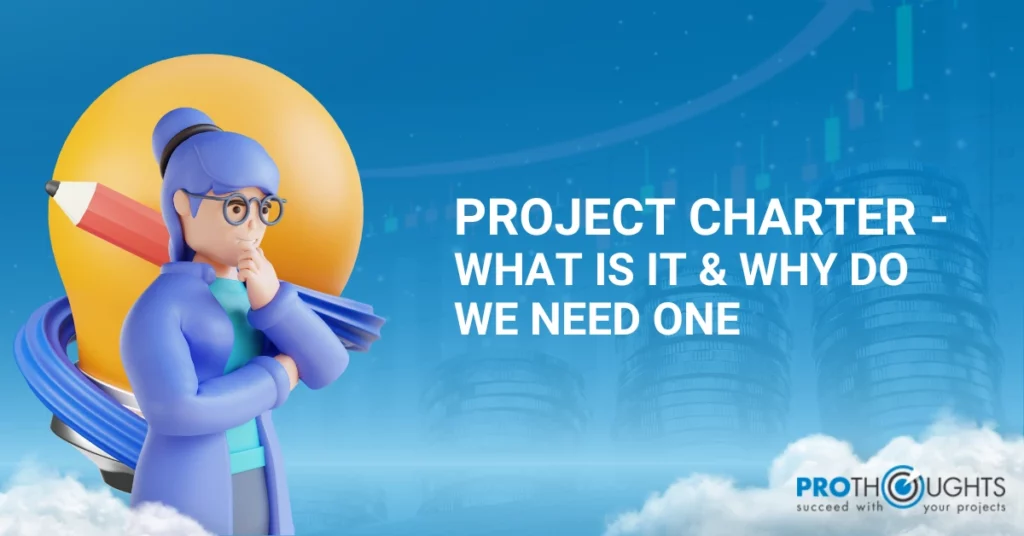In the realm of project management, a project charter holds significant importance. The Project Charter generally describes the project’s objectives and how everyone will get involved and work together to accomplish them. It, therefore, ensures that everyone is on the same page and understands what they are working towards.
It, therefore, also eliminates misunderstandings and confrontations since everyone knows their duties and responsibilities. Creating a meaningful project charter may not be the most exciting aspect of launching a new project, but it may pay off tremendously.
Enrolling in ProThoughts Solutions’ PMP Certification Training will basically guide you in creating a project charter. Our experienced trainers will walk you through defining project goals, objectives, and expectations, outlining project scope, and defining team member roles and responsibilities. With our help, you formerly can create a comprehensive project charter that ensures everyone works towards the same goal and paves the way for successful project planning and execution.
A project charter is essential in the field of project management since it acts as a core document that explains the essence and aim of a project. This article will provide a thorough overview of a project charter, including its components, benefits, and the process of developing one.
Definition of a Project Charter
A project charter is a formal document that authorizes the creation of a project and gives the project manager authority to carry it out. It describes the project’s objectives, scope, stakeholders, deliverables, schedule, and budget.
Purpose of a Project Charter
A project charter aims to provide a clear and concise project overview. It is a formal document that authorizes the project’s existence and sets its direction. Throughout the project’s lifespan, the charter acts as a reference point, ensuring everyone is on the same page.
Key Elements of a Project Charter
A project charter covers all the essential aspects of a project. It provides a comprehensive project overview, ensuring all stakeholders understand its purpose, roles, responsibilities, and other critical factors. A Project Charter generally includes the following key elements.
-
Project Description
The description generally summarizes the project’s goal, history, and context. It helps to understand the purpose of the project.
-
Project Objectives
The project objectives indeed specify the particular goals that the project intends to accomplish. They must be SMART (specific, measurable, achievable, relevant, and time-bound). Clear objectives drive the project team’s decision-making and guarantee everyone is working towards the same goal.
-
Stakeholders
Identifying and involving the key stakeholders is crucial for a project’s success. The project charter should clearly outline the main stakeholders, their roles and responsibilities, and their level of involvement in the project.
-
Project Scope
The project scope establishes the project’s boundaries. The document outlines what should and should not be part of the project. Clearly defining the project scope helps manage expectations and prevents scope creep.
-
Deliverables
Deliverables are the tangible or intangible consequences of the project. They are the outcomes that the project team and stakeholders can anticipate at the end of the project. Including deliverables in the project charter guarantees everyone understands what will be delivered.
-
Project TimeTable
The project timeline summarizes the critical milestones, activities, and deadlines during the project’s duration. It assists with scheduling and resource allocation by visually depicting the project’s progress.
-
Project Budget
The project budget specifies the projected expenses of carrying out the project. It covers labor, materials, equipment, and any other essential costs. A well-defined budget aids in financial control and decision-making throughout the project.
Benefits of Using the Project Charter
A project charter provides various advantages to project managers and stakeholders:
-
Clearly Defined Project Scope:
The project charter aids in defining the project’s boundaries and scope, providing a clear grasp of what is included and omitted. This clarity minimizes scope creep and keeps the project focused on its intended goals.
-
Stakeholders Alignment:
The project charter specifies essential stakeholders and their roles, responsibilities, and expectations. It facilitates cooperation and shared understanding by aligning stakeholders with the project’s aims. This coordination reduces disputes, enhances communication, and boosts stakeholder support and involvement.
-
Enhanced Planning and Organization:
The project charter helps better planning and organization by outlining project goals. It helps project managers to develop realistic timelines, properly allocate resources, and define achievable milestones, resulting in better project management and execution.
-
Risk Management:
The project charter evaluates potential risks and restrictions, allowing project teams to identify and reduce risks ahead of time. Teams may lower the possibility and effect of unfavorable occurrences by addressing risks early in the project, increasing project success rates.
-
Better Decision-Making:
The project charter defines a governance structure, decision-making procedures, and communication channels. This clarity enables project teams to make educated decisions, simplifies information flow, and expedites issue resolution. Better project outcomes result from effective decision-making.
-
Increased Accountability:
When the project charter outlines each team member’s roles, duties, and authority, they can better understand their individual and collective accountability. This clarity develops a sense of ownership, proactive involvement, and a culture of responsibility among the project team.
-
Efficient Resource Allocation:
The project charter includes the expected budget, necessary resources, and dependencies, assisting project managers in successfully allocating resources. It allows for improved resource planning, reducing resource overallocation or underutilization, and optimizing cost and time management.
Creating a Project Charter
Creating a Project Charter involves the following steps:
-
Gather Project Information:
The first step to building a project charter is to collect all relevant information and data. Consult subject matter experts, research, and review existing documentation to ensure accuracy and completeness.
-
Define Project Goals and Objectives:
The project manager develops the project’s goals and objectives based on the information obtained, ensuring they are precise, measurable, achievable, relevant, and time-bound (SMART).
-
Define Project Purpose and Objectives:
Clearly outline the project’s purpose and objectives based on the information obtained. Identify the problem or opportunity the project aims to address and finally determine the desired outcomes.
-
Identify the Stakeholders
Recognize all stakeholders interested in or may be impacted by the project. Consider internal and external stakeholders, and document their roles, responsibilities, and levels of influence.
-
Determine the Project Scope and Deliverables
Define the project’s scope, including what will be included and omitted. Define the exact deliverables that the project will generate.
-
Develop Project Timeline and Budget
Make a project timeline with key milestones, events, and deadlines. Estimate the project’s budget by considering the required resources, labor, and other expenses.
-
Project Template
A Project Charter template may include some or all of the following:
Why do we Need a Project Charter?
As previously stated, the primary goal of a project charter is to permit the project manager to start the project and to allow him to use organizational resources to achieve the project’s objectives.
Let us Consider an example of why we need a Project Charter.
Imagine a project underway for 2-3 months with an Authorized Project Manager overseeing its progress. Unfortunately, the current Project Manager has resigned from the organization due to unforeseen circumstances. As a result, the project has been assigned to a new Project Manager.
Every Project Manager’s first responsibility should be to read through the Project Charter to grasp its needs and eventually, its objectives. At high levels, it generally outlines clarity of the purpose, defines the scope, aligns stakeholders, manages the resources and risks, establishes communication and governance, and ensures alignment with organizational goals. Without a project charter, Project Manager would have been like a “Fish Out of Water.”
When do we Need to Create a Project Charter?
According to the PMBOK® Guide, it is formerly created during the initiation phase of a project. It generally helps to clearly understand the project goals, objectives, and expectations for all stakeholders involved. A project charter is, lastly, an essential tool that helps establish clarity, alignment, and direction for the project team and stakeholders.
Who Signs and Issues a Project Charter?
The project charter is usually signed and issued by the project sponsor or the person having project approval authority. The project sponsor is generally a senior-level member of the business who is in charge of overseeing and assuring the project’s success. Depending on the organizational structure, the sponsor might be a department head, a senior manager, or an executive.
The project sponsor is generally responsible for providing the required resources, support, and strategic direction throughout the project’s inception. They are, however, responsible for the project’s outcomes and often have the power to decide on its scope, budget, and overall direction.
Once the project charter is suddenly delivered, eventually the project sponsor evaluates and approves it. The sponsor henceforth ensures that it matches the organization’s strategic goals, addresses possible risks or issues, and is practicable given the available resources.
If the project sponsor approves the charter, they will undoubtedly sign it, showing their formal approval and authorization for the project to move forward. This signature displays the sponsor’s commitment to and support for the project and authorizes the project team to proceed with planning and execution.
Generally, stakeholders or decision-makers may review and sign the project charter depending on the organization’s processes and requirements. These persons might include, among other things, top management representatives, clients or customers, or regulatory agencies.
Finally, the project sponsor’s signature on the project charter is vital in launching the project, indicating their support and dedication to its success.
Conclusion
Finally, a project charter is critical in project management. It is a vital document providing project teams and stakeholders clarity, direction, and alignment. The project charter generally guarantees project success by establishing a proper structure for project execution, from specifying the project scope to improving decision-making and increasing responsibility.
If you undoubtedly want to learn more about project charters and other elements of project management, look for ProThoughts PMP Certification Course. The purpose of this course is formerly to provide you with an understanding of the role of a project manager and the importance of the project charter.
FAQs
What is Project Charter?
It is an official document that establishes the project’s existence. It eventually includes the goals, resource requirements, and scope details.
Why is Project Charter Important?
It is essential because it altogether lays the groundwork for success. It brings stakeholders together, specifies project objectives, and serves as a road map for decision-making and risk management.
Who should be involved in creating a project charter?
Developing a project charter necessitates the participation of important stakeholders such as project sponsors, team members, and clients. It is also critical to solicit feedback from those vested interest in the project’s success.
What is the difference between a project charter and a scope of work?
A statement of work is a detailed document that is legally binding. On the other hand, the project charter is brief and non-legal.
What does a project charter consist of?
It specifically includes all stakeholders’ goals, objectives, and expectations. It also outlines the project scope and defines the roles and responsibilities of team members.


